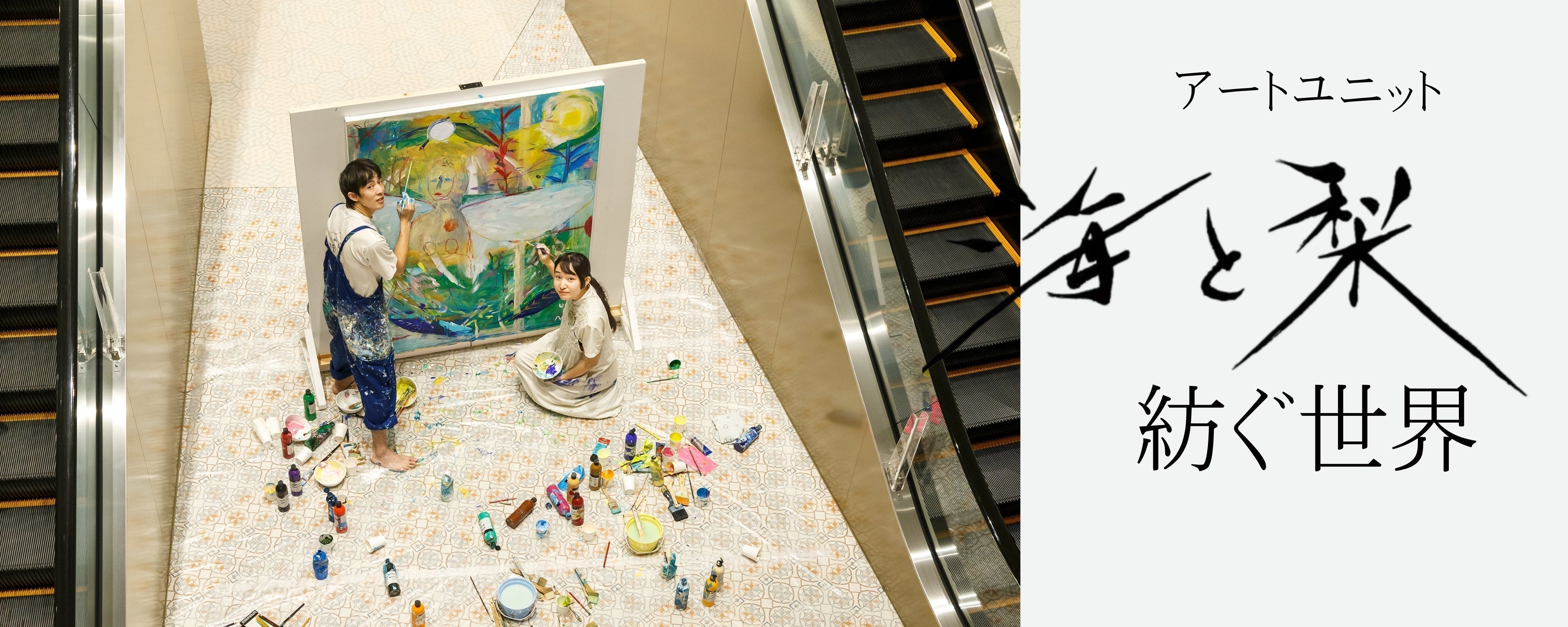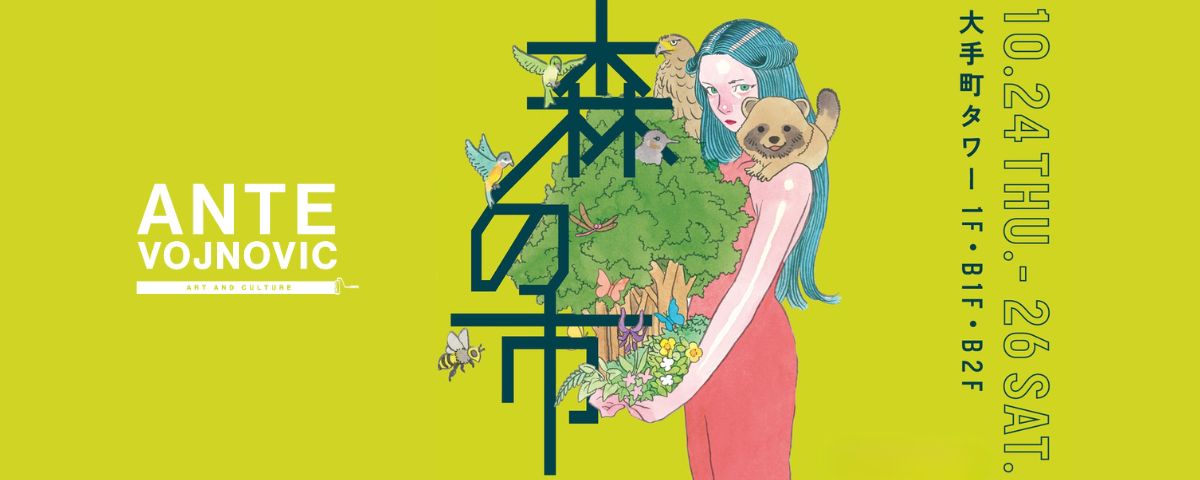The world spun by the art unit "Umi to Nashi" - The origin of creativity - Part 2
Umi to Nashi is a unit that produces and manages art paintings and the jewelry brand Leon art jewelry. The duo began their activities in 2019 and have combined their respective sensibilities to create unique expressions.
In this article, we will learn more about their creative approach and collaborative work through a live painting session.

--I'd like to ask you about the paintings you create together and your live paintings.
Do you remember the difference between creating in front of an audience and creating in your studio, and the emotions you felt at the time?
Kaito: At the time, we were going to do it in a place with a lot of people, so I was quite conscious of that. I think it's interesting to go towards one goal, but I thought it would be better to have some kind of dramatic development. So, if it looked like we were heading straight for the goal, I'd break it down for a moment and try to create a different development. I was conscious of that and made changes at the time.
--Do you feel a stronger desire to create something unexpected when working in front of others than when working in your studio?
Kaito: That's right. I felt that even more, or rather, I felt it very strongly. I wanted to entertain people because someone was watching. And also, because it was live painting, it was something that could be seen. It's nice to look at the finished work, but within it, various things pile up like layers, like geological strata.
With live painting, people can see the moment when the layers pile up. I felt that this was something that could only be done through live painting, and that it was something that could be seen, so I felt that I was more conscious of it.
--Rino, is there anything that you remember?
Rino: Since it was a live painting, I just focused on the thoughts that were welling up inside me at the time, the situation around me, and ideas that reacted to the situation around me.
-When you were doing live painting, how much were you influenced by the atmosphere, sounds, smells, etc. of the venue?
Kaito: That's a pretty big part of it.
Rino: I think I was influenced by about the third person.
Kaito: That's why we sometimes do live painting while playing music.
I want to incorporate outside influences. The fact that we're drawing together means that Rino is a foreign object to me. Unlike when I draw alone, incorporating multiple influences is also an experiment to see what kind of work I can create.
Also, I might have simply painted over it, but there was a Blue Bottle Coffee there and I saw the logo, so I tried drawing the bottle, or something direct like that. Also, when we draw outside together, we pick up fallen tree branches. When we did it at an art fair recently, we picked up stones on the side of the road on the way to the venue and used them to draw, that kind of thing.

--What are the fun and difficult aspects of creating something together?
Rino: I started creating in 2019, and the people I meet every day, and the things I do in my life now, have made me feel purely happy. Feelings of joy have been welling up inside me all the time. I want to incorporate that into my paintings. I want to depict happenings, outside influences, and the situation I'm in now, and when I painted the two of them, I wanted to express that. I'm not particularly conscious of the difficulty of it, but I do tend to do things casually. The works I've created are completely different from what I had in mind, and I don't think they were what I had in mind at all. I think that's okay in itself.
Kaito: Since we were drawing together, I was hoping to create something that was outside the realm of my imagination. That's what's fun about drawing together, but also what makes it difficult.
Rino: In particular, we started our activities at the same time as the coronavirus outbreak. With all social activities coming to a halt, it made us realize that each and every encounter is something we shouldn't take for granted.
- Meeting someone influences you in many ways, and I think that may be due to the personalities of both of you. Aside from your work, is there anything about each other that you respect?
Kaito: That's right. I think she has a very strong attitude of wanting to do something for others first, rather than just thinking about herself. That's the kind of person she is, so I really respect that. She doesn't ask for things from others, but is always thinking about wanting to do something for others, and that's what I respect about her.
Rino: Not at all. Maybe she has something I don't have. She's kind to people.
--Do you ever get the feeling that there is something that is not you when you are creating a work of art?
Rino: Yes, there are. Whenever I have a small problem and he paints it over, it solves it. When I'm alone and struggling with something, he draws it so that I can move on to the next step, and I think, "Wow, that's amazing."
--When you start creating something, is there anything you keep in mind or decide on first?
Kaito: The only thing we've decided is that we accept each other.
Rino: That's right.
Kaito: Even if the other person does something different than what I wanted to do, we have to accept it. That's the only rule we have. Otherwise there's no point in drawing together.
Also, in some cases, for example, I'll play music while I'm painting a picture, and when the music ends, the painting is finished. It's like I'm experimenting and deciding on restrictions like that. Or maybe I'll try painting without using a brush. Sometimes I decide these things beforehand for each painting, and sometimes I don't decide anything at all.
--You're always taking on new challenges under all sorts of conditions. When you're experimenting with things like short time, have you ever had an experience where you created something completely different from when you were just writing together?
Kaito: To be more specific, when I have little time, I approach the work with momentum. The finished picture has momentum, and there's a difference between lines drawn slowly and lines drawn close together. The differences in the details of the lines also come out.
Rino: Our teacher, Kimura Takahiro, always used to say, "Art is a matter of chance." That's something that's been on my mind, and I do feel like I'm doing all sorts of things to intentionally make chance happen.
--I think Kimura-san's influence was quite large, but is there anything that you two hold dear after receiving his guidance?
Kaito: One of the features of Kimura-sensei's classes is that he doesn't teach techniques. That is, instead of teaching the fundamentals of drawing, such as sketching, how to paint, how to create, or composition, he mainly teaches ideas like "drawing is a matter of chance," as Rino said earlier.
I'm particularly conscious of turning chance into inevitability. I observe the painting in detail, judge what I've drawn unconsciously, and by being conscious of it, I make it inevitable.
That was a really big idea for me, or something I was taught. Turning coincidences into inevitabilities is an important thing in the world. I don't want to say too big a thing, but I think it applies to life as well.
I think it's about facing things head on. I think it's important to judge each element of a picture properly when creating an image.
--Among the works you have created together, is there any that you are particularly attached to?
Rino: But even now, I still really like the paintings I did at New Man Yokohama.
I think the time it took to draw it was short.
--It was about two hours. Rino, is there any part of this that you particularly remember or that made an impression on you?
Rino: Hmm, I'm trying so hard to remember.
However, the venue, New Man Yokohama, was very stylish and I imagined it would be filled with light, so I think I wanted to capture that kind of atmosphere in the painting.

This concludes the second installment of the series.
Next time, we will delve deeper into the future of their creative endeavors.
[Editor's Note]
This time, it was clear that the two of them were accepting each other and the world as they created their work.
Each and every encounter is not something to be taken for granted.
Making coincidences inevitable.
I can sense your curiosity and kindness towards the world.
Perhaps the reason we find ourselves staring at the works is because the atmosphere is reflected in them.
Interviewer/writer: Kotone Mizutani and Fumika Kamiyama






















